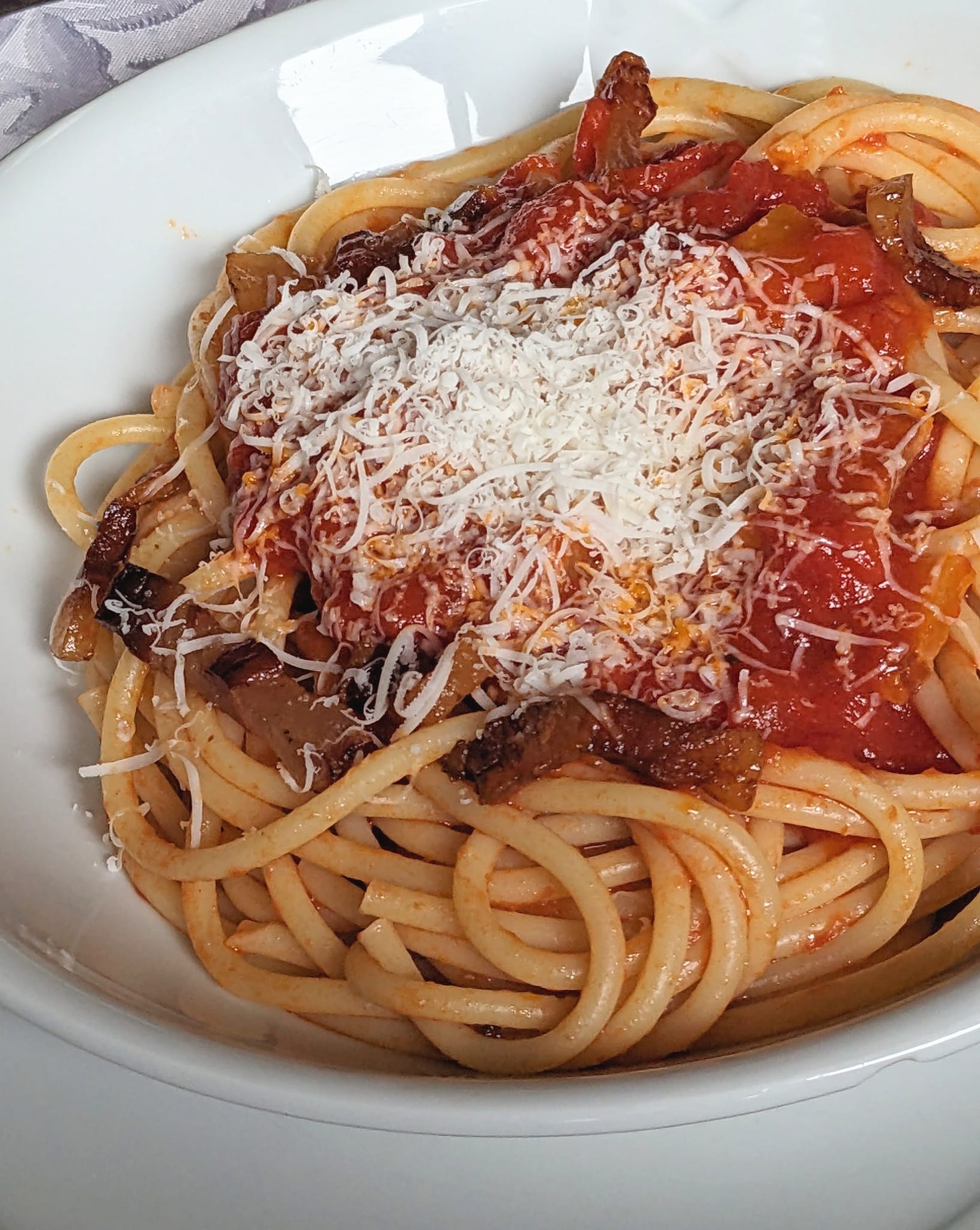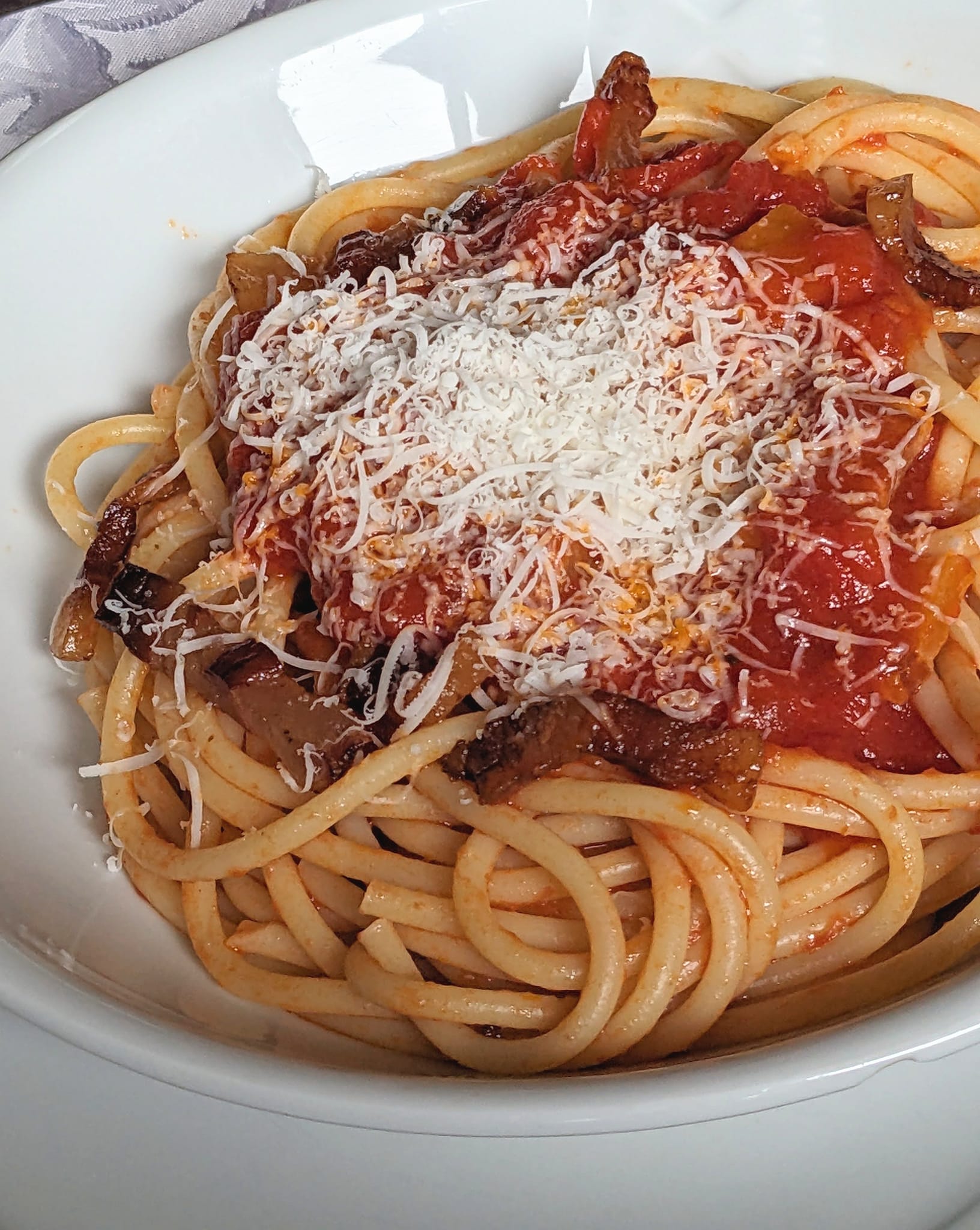Bucatini all’Amatriciana
Bucatini all’Amatriciana is a classic Italian pasta dish hailing from the town of Amatrice, known for its simple yet bold flavors. This dish features bucatini pasta coated in a rich tomato sauce made with crispy guanciale (or pancetta/bacon), garlic, onion, and a touch of heat from red pepper flakes.
The savory, salty guanciale pairs perfectly with the tangy tomatoes, creating a comforting and satisfying meal.
Finished with a generous sprinkle of Pecorino cheese, this dish offers a perfect balance of richness and spice, making it a beloved staple in Italian cuisine.
Why You’ll Love Bucatini all’Amatriciana
People will love Bucatini all’Amatriciana because it brings together bold, irresistible flavors in a simple yet satisfying way.
The crispy guanciale (or pancetta/bacon) adds a savory richness, while the crushed tomatoes create a tangy, slightly sweet base.
The hint of heat from the red pepper flakes and the depth of flavor from sautéed onions and garlic make every bite exciting.
The thick, tube-like bucatini pasta perfectly holds the sauce, ensuring that each forkful is packed with flavor.
Finished with a generous sprinkle of Pecorino cheese, this dish strikes a perfect balance of salty, savory, and spicy, making it a comfort food favorite that’s hard to resist!
Key Ingredients
Guanciale (or pancetta/bacon): A traditional cured pork product that adds rich, salty flavor and crisp texture to the sauce.
Bucatini pasta: A thick, hollow pasta that holds sauce wonderfully, making each bite hearty and satisfying.
Crushed tomatoes: The base of the sauce, offering a tangy, slightly sweet depth that balances the richness of the guanciale.
Olive oil: Used to sauté the guanciale and create a flavorful base for the sauce.
Onion and garlic: Essential aromatics that provide sweetness and savory depth to the sauce.
Pecorino cheese: A sharp, salty cheese that’s grated over the finished dish for an extra layer of richness and flavor.
Red pepper flakes and black pepper: Add a touch of heat and spice to enhance the overall flavor profile.
Bucatini all’Amatriciana


Ingredients
2 Tbsp. extra-virgin olive oil
4 oz. thinly sliced guanciale, pancetta, or chopped unsmoked bacon
½ tsp. crushed red pepper flakes
½ tsp. freshly ground black pepper
¾ cup minced onion
2 cloves garlic, minced
1 28-oz. can peeled tomatoes with juices, crushed by hand
Kosher salt
12 oz. dried bucatini or spaghetti
¼ cup finely grated Pecorino (about 1 oz.)
Instructions:
Step 1
Heat oil in a Dutch oven or large heavy skillet over medium heat.
Add guanciale and sauté until crisp and golden, about 4 minutes.
Add pepper flakes and black pepper; stir for 10 seconds.
Add onion and garlic; cook, stirring often, until soft, about 8 minutes.
Add tomatoes, reduce heat to low, and cook, stirring occasionally, until sauce thickens, 15-20 minutes.
Step 2
Meanwhile, bring a large pot of water to a boil.
Season with salt; add the pasta and cook, stirring occasionally, until 2 minutes before al dente.
Drain, reserving 1 cup of pasta cooking water.
Step 3
Add drained pasta to sauce in skillet and toss vigorously with tongs to coat.
Add 1/2 cup of the reserved pasta water and cook until sauce coats pasta and pasta is al dente, about 2 minutes.
(Add a little pasta water if sauce is too dry.)
Stir in cheese and transfer pasta to warmed bowls.
Notes:
Choose the Right Meat: Opt for guanciale if you can find it, as it provides a unique flavor and texture. Pancetta or chopped unsmoked bacon are good alternatives, but adjust the cooking time slightly as they might cook faster than guanciale.
Control the Heat: Adjust the amount of crushed red pepper flakes based on your spice preference. Start with the recommended amount and add more if you like it spicier, or reduce if you prefer a milder dish.
Caramelization of Onions and Garlic: Take your time to cook the onions and garlic until they are soft and translucent. This builds a flavorful base for the sauce.
Tomato Quality: Since the sauce relies heavily on tomatoes, use high-quality canned tomatoes or fresh tomatoes in season. Crushing them by hand gives a rustic texture to the sauce.
Salt the Pasta Water: Season the water generously with kosher salt before adding the pasta. This flavors the pasta from the inside out.
Timing the Pasta: Cook the pasta 2 minutes less than al dente as it will finish cooking in the sauce, absorbing flavors while maintaining a pleasant chewy texture.
Save Pasta Water: Reserve some of the pasta cooking water before draining. This starchy water helps bind the sauce to the pasta and adjust its consistency.
Toss Vigorously: When combining the pasta with the sauce, toss it vigorously with tongs. This helps the pasta absorb the sauce evenly and ensures every strand is coated.
Finish with Cheese: Add the finely grated Pecorino cheese at the end and toss again. This adds a creamy texture and salty kick to the dish.
Serve Immediately: Transfer the pasta to warmed bowls promptly after tossing with the sauce. This ensures it stays hot and maintains its optimal texture.
Garnish Thoughtfully: Consider garnishing with extra Pecorino cheese and a sprinkle of freshly ground black pepper for added flavor and presentation.
Nutrition Information:
YIELDS: 4 | SERVING SIZE: 1
One serving contains: Calories (Kcal) 524.6 %Calories From Fat 25.2 Fat (G) 14.7 Saturated Fat (G) 4.0 Cholesterol (Mg) 14.7 Carbohydrates (G) 75.9 Dietary Fiber (G) 6.0 Total Sugars (G) 7.4 Net Carbs (G) 69.9 Protein (G) 19.4 Sodium (Mg) 757.8
Frequently Asked Questions:
What is guanciale, and can I substitute it with other ingredients?
Guanciale is cured pork cheek.
You can substitute it with pancetta or chopped unsmoked bacon for a similar flavor.
Is there a vegetarian version of Bucatini all’Amatriciana?
Yes, you can omit the guanciale or bacon for a vegetarian version.
Consider adding extra flavor with ingredients like sun-dried tomatoes or olives.
Can I use fresh tomatoes instead of canned tomatoes?
Yes, you can use fresh tomatoes, but you may need to adjust the cooking time to allow them to break down and create a sauce.
What’s the difference between bucatini and spaghetti?
Bucatini is a thicker pasta with a hollow center, while spaghetti is a thin, long, and cylindrical pasta.
The choice depends on your preference for texture and thickness.
Can I make this dish with gluten-free pasta?
Absolutely, you can use gluten-free pasta as a substitute.
How do I store leftover Bucatini all’Amatriciana?
Store leftovers in an airtight container in the refrigerator for up to 3-4 days.
Can I freeze Bucatini all’Amatriciana?
Pasta dishes with sauce may not freeze well as the texture can change, but you can freeze the sauce separately and cook fresh pasta when needed.
What’s the purpose of reserving pasta cooking water?
The starchy pasta water helps create a cohesive sauce by emulsifying with the fats in the dish.
It’s useful for adjusting the consistency of the sauce.
What type of Pecorino should I use?
Use finely grated Pecorino Romano for an authentic flavor, but you can also use Parmesan if Pecorino is unavailable.
Can I add vegetables to this dish for extra nutrition?
Certainly, consider adding sautéed mushrooms, spinach, or cherry tomatoes to enhance the dish with vegetables.